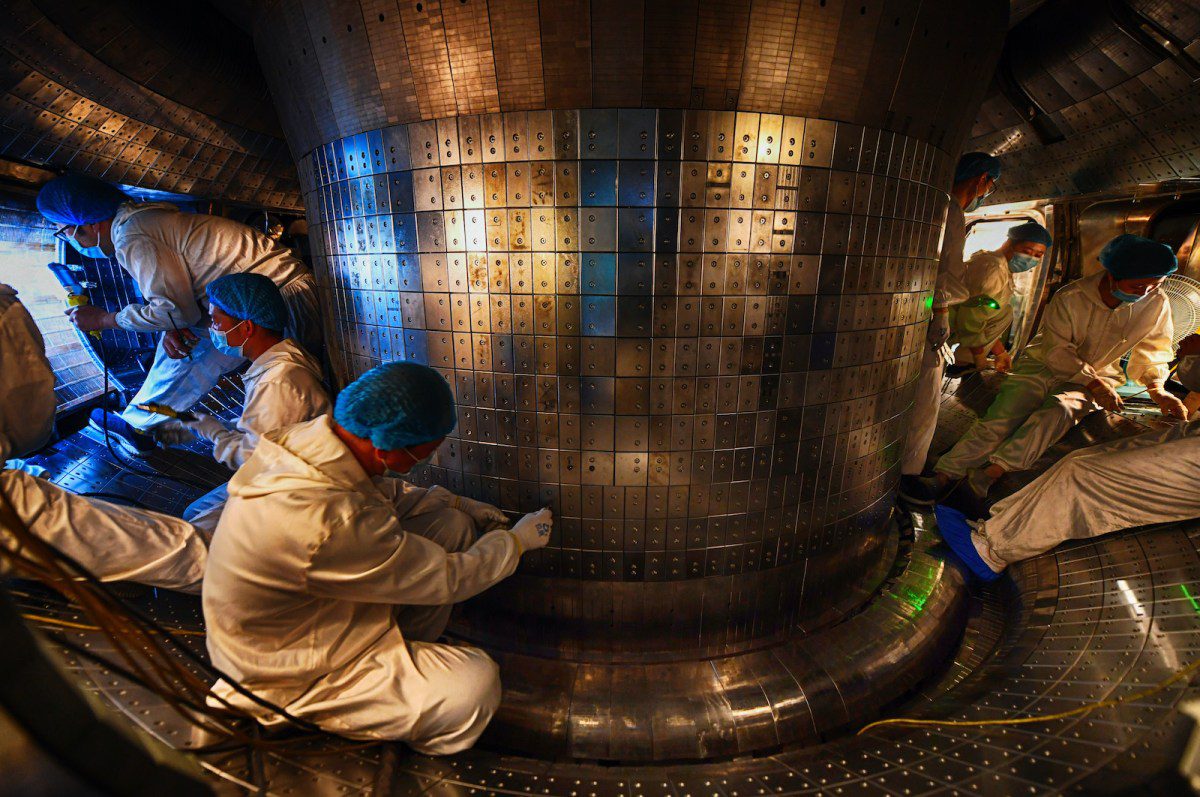Global Courant 2023-05-11 08:58:05
This is the first part of a three part series.
Thanks in large part to the performance of the Experimental Advanced Superconducting Tokamak (EAST) China has moved to the forefront of international magnetic confinement fusion research.
By using powerful magnetic fields to trap a hot plasma in its toroidal vacuum chamber, the Hefei-based EAST reactor can routinely operate at temperatures in the range of those required for deuterium-tritium fusion. -fuel.
Needless to say, holding a 100 million C° plasma “in a bottle” for a considerable time is extremely difficult. The most popular approach in fusion research to date is based on the so-called “tokamak” design, invented in the Soviet Union 70 years ago.
Until recently, individual experiments with tokamaks typically lasted only a fraction of a second, or a few seconds at most. Fusion scientists call them “shots.” Increasing the confinement time is critical to realizing significant amounts of fusion energy from tokamak devices. Here EAST leads the world.
On April 12, 2023, EAST succeeded for the first time in maintaining a plasma at 100 million C° in the dynamic state known as “H mode” for more than six minutes, where “H” stands for ” high incarceration”. This particular plasma state has long been considered particularly favorable for the stable confinement of plasmas in tokamak devices.
The giant International Toroidal Experimental Reactor (ITER), now under construction in France, is expected to operate in “H mode.” ITER claims to be the final step towards a prototype fusion power plant based on the tokamak design.
Previously, on December 30, 2021, EAST had broken all previous confinement time records by holding a plasma at a temperature in the same range for more than 17 minutes.
This was achieved in part thanks to the discovery of a previously unknown plasma state that Chinese scientists have dubbed the “Super-I mode.” It is conceivable that the “Super-I mode” – or other modes that may be discovered in the future – prove superior to the H mode for achieving fusion by tokamak devices.
Since EAST went online in 2006, it has achieved one brilliant milestone after another in addressing important technological and physics problems related to long-pulse operations.
While the EAST is not intended to generate large volumes of fusion reactions, it is an important contributor to the international fusion effort, as well as China’s project to build its own large-scale fusion reactor, the China Fusion Engineering Test Reactor (CFETR). which is now in the design phase.
Before we delve deeper into the results of EAST, it is important to place them in the larger context of the epic battle to realize fusion power with a continuously operating reactor.
China’s EAST reactor delivers groundbreaking results. Image: Xinhua
Among the many different approaches to fusion power, one can usefully distinguish between systems operating in a pulsed mode, such as laser fusion, and systems in which the fusion reactions are maintained continuously.
In this article I will only focus on this second type, which at first glance seems more suitable as a base load commercial power source. Unfortunately, realizing continuous production of energy through fusion reactions poses enormous challenges.
Among other things, the hot fusion plasma must be kept in a stable dynamic state and prevented from coming into contact with the walls of the reactor vessel. Depending on the density of the plasma, such contact can instantly vaporize wall materials and quench the fusion reactions.
Here one should bear in mind that a fusion plasma, consisting of freely moving electrons and nuclei, is a much more complicated physical system than an ordinary gas in a bottle.
High-temperature plasmas contain an enormous variety of different types of waves, oscillations and complex particle flows. By responding to external fields, they can generate powerful internal electric currents, electric and magnetic fields; they emit electromagnetic radiation over a broad spectrum with many resonance effects. Not least, they have a remarkable capacity for self-organization, which makes them difficult to control in some ways.
A physicist’s paradise, or a nightmare!
Important to our current topic is the fact that high temperature plasmas are capable of quasi-stable “modes”, in which the patterns of fields and particle motions remain relatively constant. However, they are also capable of wild, violent behavior that can cause serious damage to any device.
Our sun, which consists of plasma with an estimated core temperature of 10 million degrees, is held together by gravitational forces. We could call the sun and stars “gravity-trapped fusion reactors.”
The best and probably unique practical solution to durably confine a plasma on Earth is to suspend it in a vacuum chamber using powerful magnetic fields, a process known as magnetic confinement. Simply put, the charged particles that make up the plasma are trapped in the magnetic field lines.
The leading design for achieving durable magnetic confinement of a plasma is the tokamak, invented in 1950 by Soviet physicists Andrei Sakharov and Igor Tamm.
The Soviet T-1 tokamak. Image: Wikipedia
Tokamaks are easily identified by their toroidally shaped vacuum chamber surrounded by an array of magnetic coils that generate spiral magnetic field lines within the chamber’s interior.
Since the first experimental tokamak went into service in the Soviet Union in 1958, some 185 tokamaks have been built around the world, in many sizes and variations. Aside from the pursuit of fusion energy, tokamak experiments have played a major role in the development of plasma physics and hence astrophysics as 99% of the matter in the universe is in the plasma state.
Despite an initial euphoria, keeping a hot plasma in a steady, steady state for a considerable amount of time using a tokamak proved much more difficult than expected. A 70-year battle ensued. In this context, the self-organizing tendency of hot plasmas can be both a blessing and a curse.
On the positive side, self-organization appears to play an essential role in the formation of long-term confinement regimes, as exemplified by the “H mode” and the newly discovered “Super-I mode” in the Chinese EAST tokamak.
On the negative side, self-organizing processes are also at the root of numerous instabilities. On an astronomical scale, such instabilities are illustrated by solar flares and coronal mass ejection from our sun.
Combined with the ability of plasmas to concentrate their energy, plasma instabilities can wreak havoc on the device. In one famous case, the Tokamak de Fontenay-aux-Roses experienced a plasma perturbation in which so-called “runaway electrons” burned a hole through the vacuum chamber.
In the course of an epic battle, characterized by the repeated emergence of new plasma instabilities and other unforeseen difficulties, the performance parameters of tokamak devices have gradually improved, to the point that the realization of the net thermal output of fusion reactions in a tokamak appears within reach.
The ITER, under construction in Cadarache, France, is expected to reach this goal around 2035. In fact, ITER is currently expected to reach a “Q value” of at least 10, meaning at least 10 times as much energy will be consumed. released by fusion reactions then injected into the plasma by heating systems.
ITER itself was not designed to produce electricity, but only to provide the final stepping stone towards the first prototype electric power station, the “DEMO”.
ITER is only an intermediate step towards the production of nuclear energy. Image: ITER
In this context, it is important to emphasize that achieving Q > 10 by itself may not be sufficient to achieve a viable power plant. In addition to cost, consideration must be given not only to the output/input ratio at the plasma level, but also to the electrical power consumed by all systems in the plant, taking into account large non-recoverable thermal losses and other factors.
It is quite possible that ITER, taking advantage of the ongoing results of China’s EAST and other experiments, as well as good luck, could achieve much higher Q values, raising the prospects for a viable power plant based on ITER’s basic design.
On the other hand, it cannot be completely excluded that unforeseen difficulties prevent ITER from achieving its planned objectives.
Similar:
Loading…








